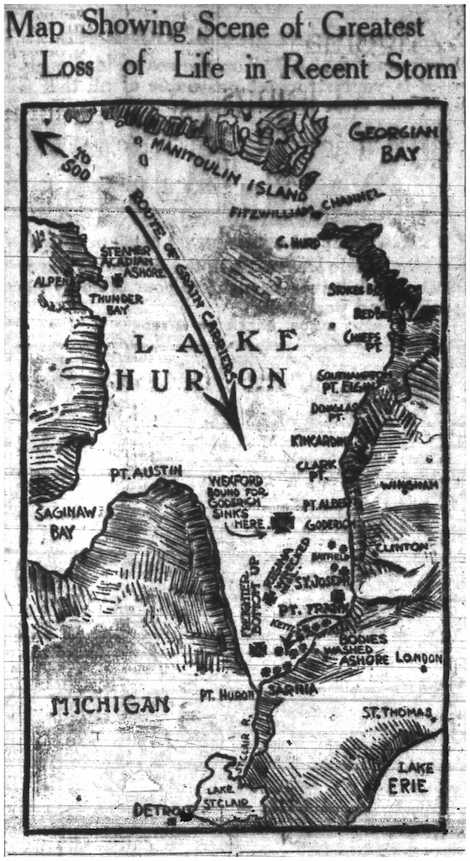.jpg)
From the Sault Ste. Marie Public Library archives:
*************************
This year we will be commemorating the 40th anniversary of the sinking of the Edmund Fitzgerald on November 10, 1975.
The rain, sleet and winds of that November storm will probably never be forgotten by the residents of this city.
The next morning, as people began to survey the damage around their homes, the frightening news came that a freighter was missing on Lake Superior and the frantic search for the lost ship began.
However, that is not the only November storm to have left its’ mark on the Great Lakes.
Between November 8 and November 10, 1913 the Great Lakes experienced the worst marine disaster to ever hit the Great Lakes.
Newspaper coverage about the storm began on November 8 reporting that a severe storm had hit Port Arthur (now Thunder Bay) with wind speeds of 50 miles per hour, rain turning to hail and ending with snow.
 The storm was also hitting the Sault and bringing the movement of ships on the St. Marys River to a standstill but it was simply considered to be a regular storm for that time of year.
The storm was also hitting the Sault and bringing the movement of ships on the St. Marys River to a standstill but it was simply considered to be a regular storm for that time of year.
The Sault Star reported on November 10, 1913 that over a foot of snow had fallen on the area since the beginning of the storm and was continuing to fall with expectations that it would pile up to 2 to 3 feet deep before the storm finally ended.
Telegraph wires were down cutting off communication with Toronto and other areas along the Great Lakes leaving residents in the dark about what was happening on the lakes around them.
Passenger ships, freighters and steamers took shelter in bays and near any island they could find, reporting that they were coated in ice from stem to stern, waiting to determine when it might finally be safe to proceed on their journeys.
Sailors had a great respect for the dangers they could encounter on Lake Superior during a storm.
Three ships had locked through at the Canadian Sault Locks and sailors reported that they were relieved to be off of Lake Superior and were looking forward to heading towards Lake Huron, not realizing that they were actually heading for disaster.
Sailors expect most storms will last about 4 – 6 hours before subsiding, however this storm raged over the entire Great Lakes basin for 4 days without letting up in intensity.
Winds increased to 60 mph, gusting to 70 mph on Lake Huron causing waves of 35 feet to crash repeatedly over the decks of the ships in the lake.
By November 11, 1913 reports began to come in describing the storm and its impact on the shipping as the “Worst Disaster in Great Lakes Shipping”.
The steamer Huronic had run aground at Whitefish Point, other vessels were reported to be pushed into shoals along the south shore of Lake Superior and one headline reported that an “Unknown Vessel Turned Turtle and Thirty Are Drowned” in Lake Huron.
Reports of more lost vessels continued to come in.
Since many of the ships were not equipped with wireless communication, shipping companies desperately waited for their vessels to report in once they reached port.
By November 14 the Sault Star reported that 26 vessels had been lost and the death toll had reached 301 people.
Two ships had run aground at Point aux Pins, and another was aground below the locks.
The Hartwell sank off Gros Cap and the A.E. Stewart and an unnamed vessel were stranded near the wreck.
The Algoma Central Lines vessel, the Leafield was missing in Lake Superior and searches were conducted along the north shore of Lake Superior but after a week of searching, all hope of finding the vessel was lost.
When the financial losses were added up later, it was estimated that a million dollars in cargo was gone and over two and a half million dollars in ships had been destroyed (based on values for 1913) during the “Big Storm of 1913”.
The cost of this disaster in today’s values would be approximately 21 million dollars in cargo and 53 million dollars in ships that were lost or destroyed but no value can ever be placed on the loss of the lives of all the sailors during The Big Storm of 1913!
*************************
Each week, the Sault Ste. Marie Public Library and its Archives provides SooToday readers with a glimpse of the city’s past.
Find out more of what the Public Library has to offer at www.ssmpl.ca and look for more Remember This? columns here.